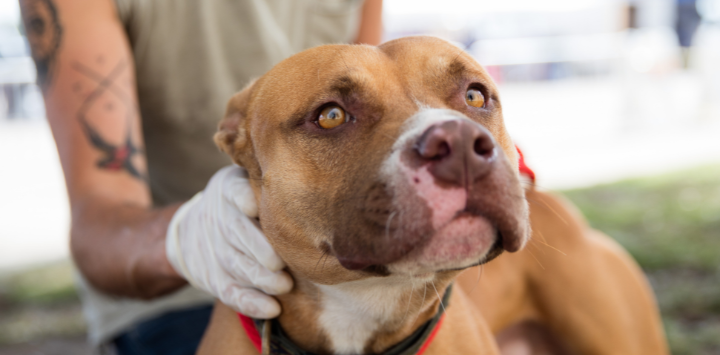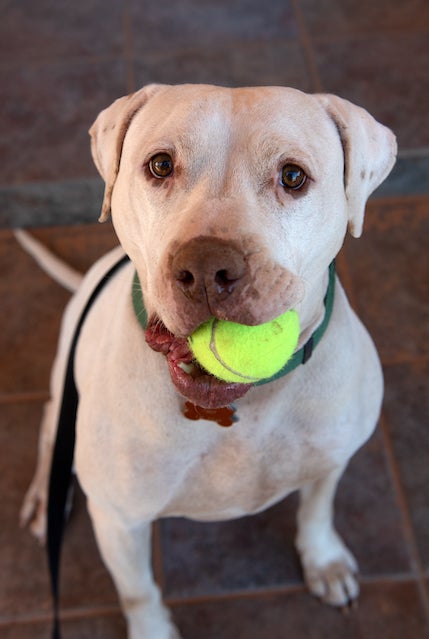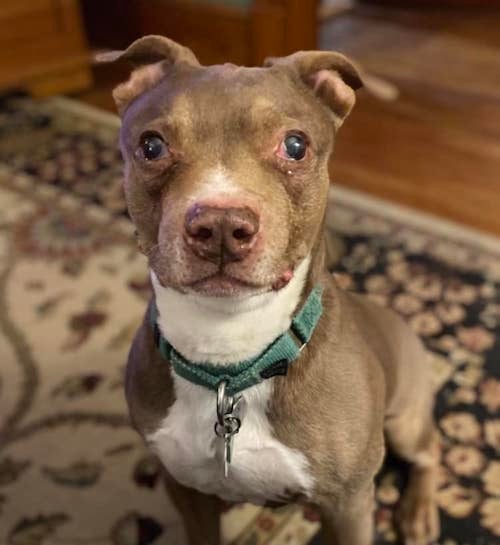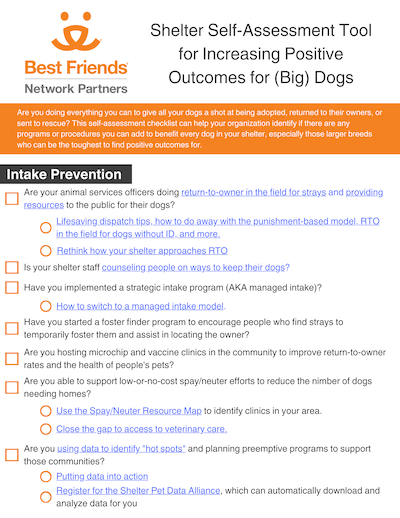
Are you doing everything you possibly can to find positive outcomes for large dogs?
 Finding homes for large dogs has long been one of the most challenging tasks facing animal shelters, though data from 2022 shows finding positive outcomes for dogs of all sizes may have gotten even more difficult post-COVID. Even the most well-mannered plus-size pooch can be passed over by adopters, a victim of everything from breed bias to restrictive housing policies. Whenever Best Friends experts consult with shelters, it’s practically guaranteed that organizations need some help with this population. We figured, why not build a self-assessment tool for shelters to make sure they are checking all the boxes in their quest for positive outcomes for dogs?
Finding homes for large dogs has long been one of the most challenging tasks facing animal shelters, though data from 2022 shows finding positive outcomes for dogs of all sizes may have gotten even more difficult post-COVID. Even the most well-mannered plus-size pooch can be passed over by adopters, a victim of everything from breed bias to restrictive housing policies. Whenever Best Friends experts consult with shelters, it’s practically guaranteed that organizations need some help with this population. We figured, why not build a self-assessment tool for shelters to make sure they are checking all the boxes in their quest for positive outcomes for dogs?
“Shelters are very busy and sometimes when you're down in it, it's hard to see what you might be missing,” says regional director Audrey Lodato, who created the checklist with Liz Stamper, senior regional strategist for the Midwest. “We are trying to look at all angles of creating live outcomes for big dogs, because that’s an area where every shelter is struggling.”
“I feel that most shelters are doing everything they can with the resources they have,” Liz says. “The goal of the list is to give organizations some extra ideas they can try.”
The checklist also includes links to resources about how shelters can implement or improve processes and programs. Below, Audrey and Liz share just a few of the topics included and why they feel those items are so important when it comes to finding positive outcomes for all your animals — big dogs especially:
Daily rounds
Liz: Rounds take time, and shelters tell themselves they don’t have the time to walk around every day. If they are doing rounds correctly, it should cut down on time it takes for other tasks.
Audrey: And doing them correctly means that there must also be a process in place for the action items that arise. I see shelters all the time doing rounds that aren’t effective because they identify all the things that need follow-up and then don't have a process to do so.
 Open adoptions
Open adoptions
Liz: This one was really easy because it’s so critical to remove bias for all of the animals in our care. We have to stop gatekeeping our animals and not letting people see them for a bunch of reasons we make up. We have to trust that people who have bothered to reach out or come into our organization to meet potential pets are serious about adding an animal to their family. If you give people a chance, most of them will pleasantly surprise you.
Length of stay (LOS)
Audrey: Staff and volunteers should have an understanding of length of stay and the impact on dogs who stay at the shelter month after month. When a certain dog has been introduced to potential adopters 10 or 20 times but doesn’t get any interest, sometimes adoptions staff or volunteers stop showing that dog. People can unfortunately start to get the mentality that nobody wants that particular dog. It’s not intentional, but it’s something to be aware of. I think what happens is they get a “reputation” sometimes even if it’s not deserved.
Liz: It’s important for your staff to understand the longer a canine is at the facility, the more behavior quirks or other forms of frustration release may set in. Understanding your LOS can help the team look at the average time a dog is at the facility and help plan for additional adoption support as they approach that average. That might involve some of the other items on this checklist like implementing fee-waived adoptions for those dogs or finding creative ways to highlight them on social.
Some organizations even re-market the canine under a different name after some time because potential adopters may get used to seeing a certain dog as available over a long period of time and jump to their own conclusion about the dog that may not be accurate. Then they’ll just pass by the kennel or the online listing. A new name gives that dog a new opportunity.
Daily stand-ups
Audrey: I swore by my daily stand-up when I ran a shelter. If you were to ask what one thing you absolutely need to run your facility, my answer would be those 10 minutes of regular meetings every day. They raise awareness of everything that is going on, so all staff and volunteers are consistently informed. Those meetings are a chance to cover everything from “Is there anything broken in the building?” to “Was there an impactful shelter death we want to recognize?” They really cover a lot in a short time and keep people feeling connected to the big picture.
Adoption barriers (housing restrictions)

Audrey: People don’t always know that they aren’t allowed to have pets, or they may not know the exact restrictions. We can help them learn how to read their lease and find out the parameters. Shelters can also help combat housing restrictions by giving the public the tools to talk to their landlords about pets, including a sample pet resume. My dog Rumble had a pet resume, and I used it at a certain apartment that was biased against pit bull-terrier type dogs. After the landlord read the resume, I took Rumble to meet him. Well, Rumble was a “pit bull” who weighed 35 pounds soaking wet and had eyes looking in opposite directions. The landlord said, ‘Oh, yeah, he seems totally safe.’ It became a non-issue, and the landlord became Rumble’s biggest fan.
Adoption barriers (municipal ordinances)
Liz: If breed barriers in your community are bigger than just those enforced by individual apartment complexes, is your shelter actively involved in the community to get those types of ordinances removed? Do you know your ordinances, and do you know who to talk to about getting them changed? The reality is, it's not that hard to get an ordinance change. You just need to make the case for it.
Adoption barriers (shelter access)

Liz: Shelters often don’t think about the hours they are open for adoptions. If you are only open during the standard 9 a.m. to 5 p.m. when many people are at work, it limits their ability to visit and potentially adopt or look for their lost dog. Some items you should consider are staying open one hour longer during the week and/or introducing/extending hours on the weekends.
At my previous facility, we ran an adoption event that went throughout the night. We expected the evening and early morning hours to be slow, however, it was one of our busiest times. We had people walking through our doors who could not join us during our normal open hours, and they loved being able to finally meet our animals. We need to consider all community members, as everyone’s job looks different, and they deserve an opportunity to adopt.
Access the Shelter Self-Assessment Tool for Increasing Positive Outcomes for (Big) Dogs here.

Liz Finch
Senior Writer
Best Friends Network
If you enjoyed this program spotlight, you can find our complete catalog of spotlights here.